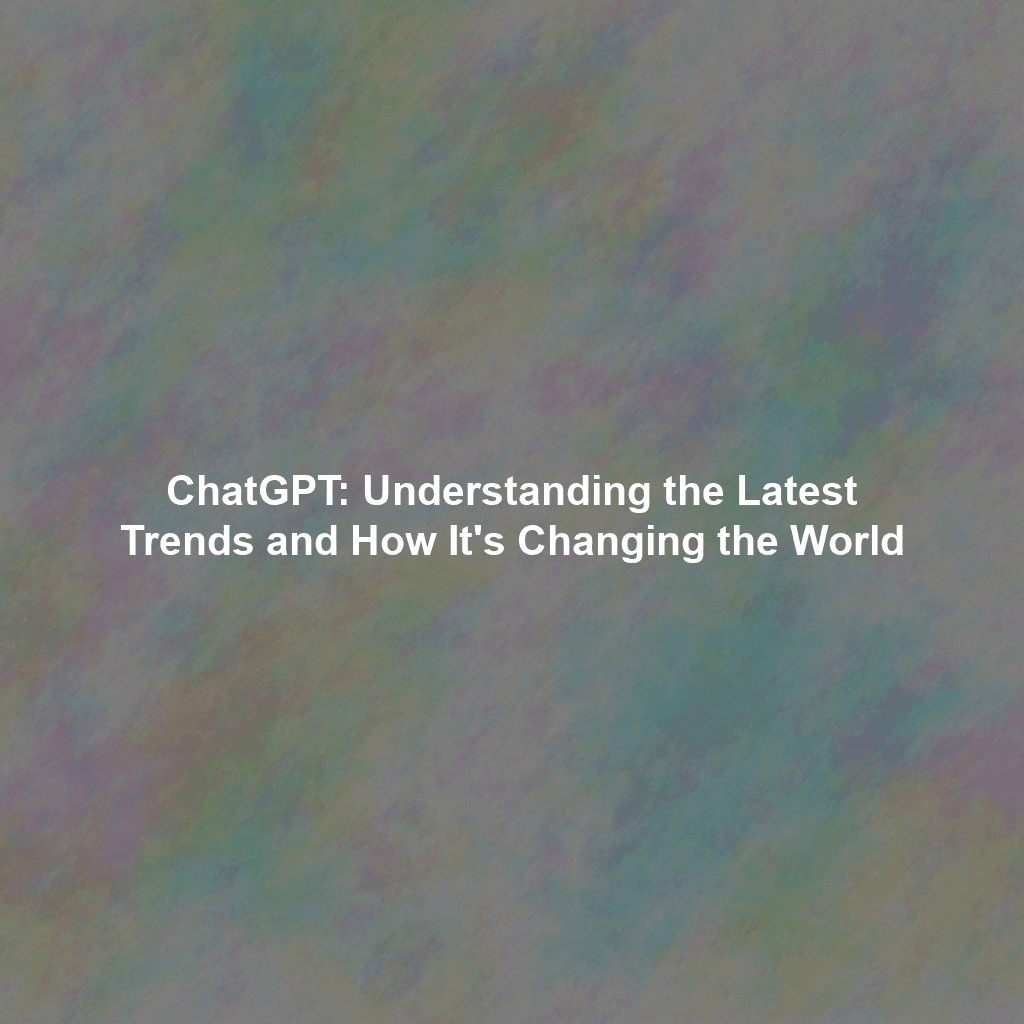What is ChatGPT and Why Should You Care?
ChatGPT, short for Chat Generative Pre-trained Transformer, is a cutting-edge language model developed by OpenAI. It’s designed to understand and generate human-like text, making it a powerful tool for various applications, from answering questions and writing emails to creating code and translating languages. If you’re curious about artificial intelligence, understanding ChatGPT is crucial, as it represents a significant leap in AI capabilities and is rapidly changing how we interact with technology.
This blog post will delve into the latest trends surrounding ChatGPT, exploring its capabilities, limitations, and potential impact on various industries. We’ll also discuss practical ways you can use ChatGPT and stay informed about its ongoing development.
ChatGPT’s Core Capabilities: A Deeper Dive
Natural Language Processing (NLP) at its Finest
At its heart, ChatGPT leverages Natural Language Processing (NLP) to understand and respond to text. This allows it to analyze the nuances of human language, including context, intent, and even subtle emotions. Unlike earlier AI models, ChatGPT can maintain context throughout a conversation, making interactions feel more natural and engaging. For example, you can ask a follow-up question without re-explaining the original topic, and ChatGPT will understand what you’re referring to.
Text Generation: From Articles to Code
ChatGPT’s text generation capabilities are incredibly versatile. It can create different kinds of creative text formats, like poems, code, scripts, musical pieces, email, letters, etc. It will try its best to fulfill all your requirements. It can write entire articles on various topics, generate code in multiple programming languages (like Python, Javascript, and C++), and even assist with creative writing projects. The quality of the generated text often depends on the clarity and specificity of the prompt provided. The more detailed your instructions, the better the output will be.
Translation and Summarization: Breaking Down Language Barriers
ChatGPT excels at translating languages, allowing for seamless communication across different linguistic backgrounds. It can also summarize lengthy documents, extracting key information and presenting it in a concise and easily digestible format. This is particularly useful for researchers, students, and anyone who needs to quickly grasp the essence of a large body of text. Tools like Google Translate demonstrate similar translation capabilities, but ChatGPT’s ability to understand context often leads to more accurate and nuanced translations.
Latest Trends and Developments in ChatGPT
GPT-4 and Beyond: The Next Generation of Language Models
OpenAI continuously releases new versions of ChatGPT, each with improved capabilities and performance. GPT-4, the latest iteration, boasts enhanced reasoning skills, more accurate responses, and the ability to process images as well as text. Future versions are expected to further refine these abilities, potentially incorporating multimodal learning (the ability to learn from multiple types of data, such as audio and video) and improved contextual understanding.
Plugins and Integrations: Expanding ChatGPT’s Functionality
One of the most exciting developments is the integration of plugins with ChatGPT. These plugins allow ChatGPT to connect to external services and access real-time information, significantly expanding its functionality. For example, a plugin could enable ChatGPT to book flights, order groceries, or access up-to-date news articles. This integration transforms ChatGPT from a simple chatbot into a powerful personal assistant.
The Rise of Fine-Tuned Models: Specializing ChatGPT for Specific Tasks
While ChatGPT is a general-purpose language model, fine-tuning allows developers to specialize it for specific tasks and industries. By training ChatGPT on a specific dataset, it can be optimized for applications like customer service, medical diagnosis, or legal research. This fine-tuning process can significantly improve the accuracy and relevance of ChatGPT’s responses in these specialized domains.
Ethical Considerations: Addressing Bias and Misinformation
As ChatGPT becomes more powerful, it’s crucial to address the ethical considerations surrounding its use. One major concern is the potential for bias in the model’s responses, which can reflect the biases present in the training data. OpenAI and other researchers are actively working on techniques to mitigate bias and ensure that ChatGPT provides fair and unbiased information. Another concern is the potential for misinformation, as ChatGPT can be used to generate realistic but false information. It’s important to be critical of the information generated by ChatGPT and to verify it with reliable sources.
Organizations like the Partnership on AI are working to address these ethical concerns and promote responsible AI development. You can find more information about their work at Partnership on AI.
Practical Applications of ChatGPT: How You Can Use It Today
Content Creation: Streamlining Your Writing Process
ChatGPT can be a valuable tool for content creators, helping with tasks like brainstorming ideas, outlining articles, and generating drafts. While it’s important to review and edit the generated content to ensure accuracy and originality, ChatGPT can significantly speed up the writing process. For example, you can use ChatGPT to generate a list of potential blog post topics based on a specific keyword or to create a first draft of an email.
Customer Service: Providing Instant Support
Many businesses are using ChatGPT to automate customer service interactions, providing instant support and answering frequently asked questions. ChatGPT can handle a wide range of inquiries, freeing up human agents to focus on more complex issues. This can lead to improved customer satisfaction and reduced operational costs. Companies like Zendesk are integrating AI-powered chatbots to enhance their customer service platforms.
Education: A Powerful Learning Tool
ChatGPT can be a valuable learning tool for students and educators. It can answer questions, explain complex concepts, and even provide personalized feedback on writing assignments. However, it’s important to use ChatGPT responsibly and to avoid relying on it to complete assignments without understanding the underlying concepts. Students should view ChatGPT as a tool to enhance their learning, not as a substitute for critical thinking and independent study. Resources like Khan Academy can supplement learning alongside ChatGPT.
Personal Productivity: Automating Everyday Tasks
ChatGPT can help automate everyday tasks, such as scheduling appointments, setting reminders, and managing emails. By integrating ChatGPT with other productivity tools, you can streamline your workflow and free up time for more important activities. For example, you can use ChatGPT to summarize your emails, create a to-do list, or schedule a meeting with colleagues.
Limitations and Challenges of ChatGPT
Accuracy and Reliability: Verifying the Information
While ChatGPT is a powerful tool, it’s important to remember that it’s not always accurate or reliable. The model can sometimes generate incorrect or misleading information, especially on complex or niche topics. It’s crucial to verify the information provided by ChatGPT with reliable sources before using it for critical decision-making. Always double-check facts and consult with experts when necessary.
Bias and Fairness: Addressing Potential Discrimination
As mentioned earlier, ChatGPT can exhibit biases based on the data it was trained on. This can lead to discriminatory or unfair outcomes, especially in sensitive areas like hiring or loan applications. It’s important to be aware of these potential biases and to take steps to mitigate them. OpenAI is actively working on techniques to reduce bias in ChatGPT, but it’s an ongoing challenge.
Creativity and Originality: Avoiding Plagiarism
While ChatGPT can generate creative content, it’s important to ensure that the generated content is original and does not infringe on anyone’s copyright. Always cite your sources and avoid copying content directly from ChatGPT without attribution. Use ChatGPT as a tool to inspire your own creativity, rather than as a replacement for original thought.
Data Privacy and Security: Protecting Sensitive Information
When using ChatGPT, it’s important to be mindful of data privacy and security. Avoid sharing sensitive personal information with the model, as it could be stored and used for training purposes. Be aware of the terms of service and privacy policies of the platform you’re using to access ChatGPT. Consider using privacy-focused alternatives if you’re concerned about data security.
Staying Informed: Keeping Up with the Latest ChatGPT News
Following OpenAI’s Announcements
The best way to stay informed about the latest developments in ChatGPT is to follow OpenAI’s announcements and blog posts. OpenAI regularly publishes updates on new features, research findings, and ethical considerations. You can subscribe to their newsletter or follow them on social media to stay up-to-date.
Reading Industry News and Research Papers
Stay informed about ChatGPT and AI trends by regularly reading industry news and research papers. Websites like TechCrunch and Wired often publish articles about AI advancements, and platforms like arXiv host pre-prints of scientific papers. This will help you understand the broader context of ChatGPT’s development and its potential impact on society.
Participating in Online Communities
Join online communities and forums dedicated to AI and ChatGPT to connect with other enthusiasts and experts. These communities can be a valuable source of information, providing insights into practical applications, troubleshooting tips, and discussions about ethical considerations. Platforms like Reddit and Discord host numerous AI-related communities.
The Future of ChatGPT: What to Expect
ChatGPT is a rapidly evolving technology, and its future is full of exciting possibilities. We can expect to see further improvements in its accuracy, reasoning skills, and ability to understand and respond to complex queries. The integration of plugins and other external services will continue to expand its functionality, making it an even more powerful tool for various applications. As AI technology continues to advance, ChatGPT is likely to play an increasingly important role in shaping our future.
The ongoing research and development in areas like artificial general intelligence (AGI) could lead to even more transformative advancements in language models like ChatGPT. While AGI is still a distant goal, it represents the ultimate potential of AI to match or exceed human intelligence in all domains. You can read more about AGI on Wikipedia at Artificial General Intelligence.
Conclusion
ChatGPT represents a significant advancement in AI technology, offering a wide range of capabilities and applications. By understanding its core functionalities, latest trends, and limitations, you can effectively leverage ChatGPT to enhance your productivity, creativity, and learning. As ChatGPT continues to evolve, staying informed and engaging with the AI community will be crucial to navigating its potential and addressing its ethical considerations. Embrace the power of ChatGPT, but always use it responsibly and critically.
 Skip to content
Skip to content
